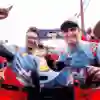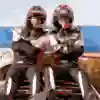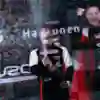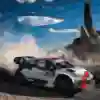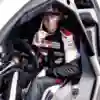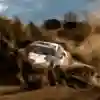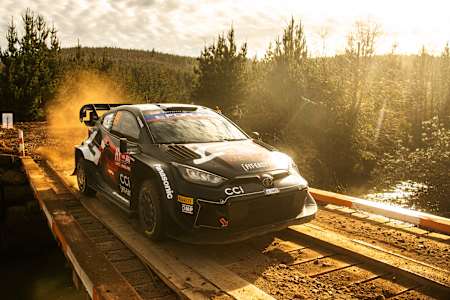
WRC
Elite motorsport never stands still and the World Rally Championship is entering a new era as four champions compete for top honours. Here's everything you need to know about WRC 2025.
Summary
- 1What's new in the Drivers' Championship?
- 2Kalle Rovanperä is back
- 3Driver line-up: Hyundai Shell Mobis World Rally Team
- 4Driver line-up: Toyota Gazoo Racing World Rally Team
- 5The return of WRC legend Juha Kankkunen
- 6What about WRC strategy?
- 7Hybrid power is out for 2025
- 8Where to watch WRC for free
- 9What happens at a WRC rally?
- 10The new 48hr Rally Sprint format
- 11How to win the World Rally Championship
- 12The 2025 Rally World Championship calendar
- 13A quick history of the WRC
- 14The development of World Rally cars
- 15A WRC round from Kalle Rovanperä’s POV
- 16The rules of WRC
- 17The WRC support series
It's the return of the king as the new WRC champion Thierry Neuville faces the series' youngest-ever champ Kalle Rovanperä, as well as 2019 title holder Ott Tänak and eight-time champion Sébastien Ogier. With new events, the WRC is heading into a new era of competition and the future is looking bright, so here's everything you need to know about the World Rally Championship in 2025.
01
What's new in the Drivers' Championship?
There's a new world champion in Thierry Neuville, as the Belgian led the championship from the opening round of the season in Monte Carlo all the way to sealing the title at the season-ending Rally Japan. Leading the championship made it a much tougher challenge for the five-time runner-up, as it meant the Hyundai star had to take on the role of road sweeper at every rally – a particularly difficult role on snow and gravel.
It drew on every fibre of Neuville's skill, professionalism and experience, as he scored vital points – including a brilliant win at the Acropolis Rally – and ultimately wrapped up the crown when his team-mate Ott Tänak crashed out on the final morning of the championship. “I’m very proud and very happy. It’s the reward for years of fighting and never giving up," Neuville said at the finish.
So 2025 starts with a title defence for the 36-year-old – let’s look at his competition…
02
Kalle Rovanperä is back
The record-breaking two-time World Rally champion returns to the competition full-time after having sat out much of 2024 to explore other projects, including drift racing and driving an F1 car around the Red Bull Ring.
Even on a limited schedule, the youngest-ever WRC champion won the Safari Rally as well as Poland, Latvia and Chile, proving unstoppable on asphalt, gravel and dirt. He will be the man to beat as he resumes action with Toyota.
"I think my batteries have recharged, yes," Rovanpera said. "I'm really excited that I'll be driving the full WRC season again next year. This year has been quite different for me, driving a few different cars and still winning some rallies at the same time," he added. "It's been a nice year, but it's also given me a lot of motivation to return and push for championships."
03
Driver line-up: Hyundai Shell Mobis World Rally Team
Hyundai are back with a strong and balanced line-up, with Neuville – widely regarded as a Tarmac specialist but perfectly capable of winning on any surface – and 2019 world champion Ott Tänak. The Estonian is especially quick on gravel, but in 2024 he took his first win on asphalt in more than two years at the Central European Rally.
The question at Hyundai is whether they will be joined by a third full-time driver or field a selection of part-time drivers. In 2024, Esapekka Lappi, Andreas Mikkelsen and Dani Sordo shared driving duties and team principal Cyril Abiteboul praised the "excellent job" they did – Lappi won the challenging Rally Sweden. The rumour in the service park however is that Adrien Formaux is set to move to Hyundai, with Oliver Solberg favourite to fill his seat at M-Sport. Ali Türkkan, meanwhile, will get two Rally1 drives after a strong test in an M-Sport Ford Puma Rally1.
04
Driver line-up: Toyota Gazoo Racing World Rally Team
While Hyundai won their first Drivers' Championship, Toyota snatched the Teams' Championship title thanks to Elfyn Evans’s win in the final round in Japan. Having finished runner-up in the WRC for a fourth time, the Welshman will be going all out for the title with Toyota in 2025. Rovanperä is back and Takamoto Katsuta is also set to continue with the team, having re-signed at the end of Rally Japan, and 2024 WRC2 champion Sami Pajari also gets a full-time drive in a fourth GR Yaris Rally1. Then, eight-time WRC champion Sébastien Ogier will compete at selected rallies in a fifth car.
05
The return of WRC legend Juha Kankkunen
Behind scenes at the Jyväskylä-based Toyota team, boss Jari-Matti Latvala will take part in the 2025 European Historic Rally Championship, which means four-time champion Juha Kankkunen will return to the service park to deputise for his countryman. Kankkunen is no stranger, having driven for Toyota for nine years and winning his fourth and final world title in a Celica in 1993. A driver-friendly team boss, the Finn brings a wealth of experience having first competed in the WRC in 1979 and winning 23 rallies and four championships, as well as the 1988 Dakar Rally.
06
What about WRC strategy?
Rally is intense. The drivers have to tackle four stages per session, following their pace notes to the letter while also responding to changes in the track surface. They can make repairs on the road, such as changing a flat tyre, but serious repairs have to be done at the service park. And fastest isn't always best: the first-placed driver opens the first stage the next morning. Drivers call this sweeping because overnight the surface will have got dirty and slippery, which puts the lead driver at a disadvantage, especially on gravel. This was one of the biggest obstacles facing Thierry Neuville as he fought for the 2024 title.
07
Hybrid power is out for 2025
WRC faces a balancing act of trying to keep rallying exciting not only for fans, but also manufacturers. The sport is pulled in two different directions given the need to develop fuel-efficient vehicles that use both sustainable fuels and emerging technology such as hydrogen power. In the end, the agreement has been to drop the expensive and complex hybrid units introduced in 2022.
From 2025, Rally1 cars will now be powered by 1.6-litre turbocharged internal combustion engines that run on 100 percent sustainable fuels, helping to lower the costs faced by teams. Stripped of the 87kg hybrid kit, the cars will also be much lighter with the minimum weight of Rally1 cars, dropping from 1,260kg to 1,180kg. This means greater acceleration for less fuel.
08
Where to watch WRC for free
Watch free WRC highlights on Red Bull TV, which delivers WRC highlights every Friday, Saturday and Sunday. Witness the day's most heart-stopping moments without subscriptions. Head to Red Bull TV or download the app and search 'FIA World Rally Championship' to fuel your rally spirit.
09
What happens at a WRC rally?
The World Rally Championship is truly global, taking place across four continents and on a variety of surfaces from asphalt to gravel to dirt and snow. Drivers compete in temperatures from as hot as 42°C to as cold as -30°C. A rally is also a long event, starting with…
Recce: Usually two days, where the crew practise the route at a limited speed to make detailed pace notes. In circuit racing, drivers lap the track 200 times during the weekend, but rally drivers may see a stage once a year. Recce helps them to determine their approach and exit speed, and make a note of such hazards as water, rocks and jumps.
Shakedown: Thursday morning is a full-speed test where teams fine-tune the setup of their cars to suit the surface. Extremes would be chunky tyres, high ride height and maximum play in the suspension for bumpy gravel stages and thin tyres, low-ride and stiff suspension for Tarmac.
Super Special Stage: Thursday evening is the ceremonial start, followed by a crowd-pleasing Super Special Stage in the host city. The SSS take a variety of formats, but among the most popular are head-to-heads, where two cars race around a looping circuit, or a sprint around a course with a selection of surfaces and obstacles.
Rally: Friday and Saturday comprise two long days of special stages, pushing cars and crews to the limit. The crews drive to the liaison at the start of the stage. Three zero cars – like pace cars in F1 – go through the stage at speed to ensure it's clear of spectators before the leading car sets its time, followed at three-minute intervals by the next fastest.
Power Stage: Sunday features another full morning of rallying and a final Power Stage in the afternoon to bring the weekend to a close. The drivers then return to the host town for the podium and closing ceremony.
10
The new 48hr Rally Sprint format
Rally Sardegna will unveil an experimental new compact schedule for a rally weekend, which sees the event run across 48 hours. Shakedown is on Friday morning, with the opening four stages run in the afternoon. There are eight stages on Saturday and the final four on Sunday morning, with the rally wrapping by early afternoon. At a total race distance of 266km, it's shorter than a full-length rally (usually 300km+) but not by much. But it is more spectator-friendly, less disruptive and expensive for organisers. If successful, this could be the shape of WRC in the future.
11
How to win the World Rally Championship
The crews and teams score points at every round, but the points scoring system has been overhauled to discourage teams from saving tyres for the Power Stage on Sunday. The top 10 finishers on Saturday score 18–15–13–10–8–6–4–3–2–1 points. On Sunday, the top seven score 7–6–5–4–3–2–1 points, plus there's 5-4-3-2-1 points for the top five in the Sunday's Power Stage, making a maximum haul of 30 points available to the best crew.
In the Manufacturers' Championship, factory teams can enter up to three cars per rally, but only the top two can score points for the championship. The crews are racing against the clock, so the winner is the one with the shortest time over all the stages – the fastest overall driver.
12
The 2025 Rally World Championship calendar
The expanded 14-round WRC 2025 calendar features the classic rounds, opening with the world's oldest rally, Monte Carlo, and taking in iconic classics such as the Safari Rally, Rally Sardegna, Rally Finland and the Acropolis Rally. Croatia, Latvia and Poland all make way to be replaced by Estonia and new stops in Spain, Paraguay and Saudi Arabia. Spain returns to WRC, but switches the action to the Canary Islands while Paraguay is back-to-back with Chile, with the season coming to a spectacular conclusion in Jeddah, Saudi Arabia.
13
A quick history of the WRC
French marque Alpine were the first champions and its stunning A110 was the star. The winning drivers? At first, that was less important than the car. It took until 1977 for a prize to be awarded to the winning driver and co-driver, but there wasn't a drivers' World Rally Champion crowned until Björn Waldegård in 1979. With ABBA topping the charts and Borg winning the tennis, 1979 was a great year to be Björn.
Since then, the title has been taken by 16 drivers with two Frenchmen dominating the record books – Sébastien Loeb with nine titles and Sébastien Ogier with eight. The 2023 world champion is the youngest ever and all signs point to the brilliant Kalle Rovanperä dominating WRC for the foreseeable future.

14
The development of World Rally cars
Since rally began, the cars have evolved as manufacturers road-test the latest developments for production cars. In the first decade, it was rear-wheel drive cars such as the Ford Escort RS, the Fiat 131 Abarth and the head-turning Lancia Stratos. In the '80s, the new Group B rules saw the introduction of turbos, which lead to the game-changing four-wheel drive Audi Quattro.
The stunning hot-hatches of Group B ushered in the glory years of WRC, but two serious accidents in 1986 spelled the end of the era and the advent of Group A. This new generation were more closely based on production cars and cheaper to produce, opening up the championship to new teams and crews. Lancia led the way with the Delta Integrale and by the '90s, the championship was dominated by the Subaru Impreza, Mitsubishi Lancer Evolution and Toyota Celica GT4.
With manufacturers struggling to make street-legal rally cars, the WRC introduced World Rally Cars in 1997, ushering in an era of dominance first for Citroën with the Xsara, C4 and DS3, and then VW and the Polo R WRC. The rules were tweaked for 2017 to give the cars much more power and more aero components to keep them planted. In 2022, WRC ushered in greener hybrids with the power to the fuel-efficient engines boosted by a 100Kw electric engine, boosting output to more than 500bhp. In 2025, those will make way for simpler and sturdy turbocharged 1.6L engines to reduce costs and increase competition in the championship.
15
A WRC round from Kalle Rovanperä’s POV
Rovanperä’s mental preparation starts days before the rally when he’ll study videos from previous rallies, mainly onboard clips, but if there is a new stage, the WRC provides recce videos to help the crews learn the stage.
When Rovanperä and co-driver Jonne Halttunen arrive at the service park, they have a long list of checks to perform, from recceing the stage to make pace notes to meeting the team to discuss the best set-ups and rally strategy. After shakedown, the ceremonial start and the Super Special on Thursday, they approach the start line at the first Special Stage. This is when the crew has to clear their minds and focus on their performance.
"When I'm actually on the start line and getting ready to drive, I have my own small routines: I clap my hands to wake me up a bit and to help me focus," explains Rovanperä. "Then I take about 20 seconds to clear my mind, shut everything out and concentrate."
Fridays are long days behind the wheel, and it’s night when the cars return to the Service Park, and it's even later before Rovanperä can have dinner and return to his hotel. “Friday is a busy day, and we don’t finish until it’s late, so after rallying, we watch videos of Saturday’s stages to prepare. It’s quite a long night.”
Saturday is another long day, and there's no let-up until after Sunday afternoon's Power Stage before heading to the finish and (hopefully) the podium. "That's the best part because a rally is six days of hard work and if you have a good result, it's a great feeling of accomplishment. It's really nice to relax and just enjoy this feeling." Sunday night might involve a fun team dinner or a reception with a sponsor or – just as likely – heading straight home ready to start prepping for the next round.
16
The rules of WRC
Bouncing over jagged rocks and huge jumps, the cars take a lot of punishment, and the driver and co-driver need to be able to carry out running repairs such as a quick tyre change or bending bodywork back in shape. The rally car is loaded with basic equipment, including various tools, duct tape and a jack to lift the car. No one else can work on the car, but fans can help push a car back onto the road or tip it back onto all four wheels – a perk of being a spectator.
Crews can’t tinker with the set-up of the car or anything that might affect performance without getting a time penalty. That can be a calculated risk but major work has to be carried out by the mechanics in the Service Park. Even then, it has to be within strictly regulated periods of 15 minutes in the morning, 30 minutes at lunchtime and 45 minutes in the evening. Overnight, the cars are locked up and stored.
If the cars can’t be fixed on stage, they can be towed back to the Service Park, and if the team can fix it, the crew can restart the next morning with a 10-minute time penalty. It’s not unheard of for teams to still pick up points after a restart from a high finish or a power stage.
If a rally car – or one of the crew – is damaged beyond repair on stage, it is retired.
17
The WRC support series
As well as the main championship, a WRC rally incorporates several support classes that act as a proving ground for talent looking for a seat in the premier championship.
WRC2: The Rally2-spec cars are the equivalent of the R5 cars, with competitive cars like the Ford Fiesta, Skoda Fabia R5 and Citroen C3, Toyota GR Yaris and Hyundai i20 N. Crews can enter up to seven rallies in the season with the best six results counting toward their championship. Limiting the number of rounds keeps costs down and creates more opportunities for drivers: in 2024, there were 50 crews competing in WRC2.
Junior WRC: This is where the future drivers of the WRC hone their skills at the major rallies in the championship and alongside the top crews and teams. Graduates include Sébastien Ogier, Elfyn Evans and Thierry Neuville. In this case, Junior is a pretty broad term, as drivers up to 30 years old are eligible to compete. To keep costs down, they drive the same Fiesta Rally3s models used in WRC3. The championship-winning crew wins free entry to compete in WRC2 at four European WRC rounds at the wheel of a Ford Fiesta Rally2 prepared by M-Sport.




























